An Analysis of the 2008 Ms 8.0 Wenchuan Earthquake’s Aftershock Activity
Abstract
:1. Introduction
2. Data and Data Completeness
2.1. Data Sources
2.2. Completeness Analysis
3. Study Methods
3.1. Magnitude–Frequency Relationship
3.2. Aftershock Decay
4. Results
4.1. Statistical Characteristics of Aftershock Sequence
4.2. Spatial Distribution of b- and p-Values
5. Discussion
6. Conclusions
Author Contributions
Funding
Institutional Review Board Statement
Informed Consent Statement
Data Availability Statement
Acknowledgments
Conflicts of Interest
References
- Gutenberg, R.; Richter, C.F. Frequency of earthquakes in California. Bull. Seism. Soc. Am. 1944, 34, 185–188. [Google Scholar] [CrossRef]
- Kisslinger, C.; Jones, L.M. Properties of aftershocks in southern California. J. Geophys. Res. 1991, 96, 11947–11958. [Google Scholar] [CrossRef]
- Utsu, T.; Ogata, Y.; Matsu’ura, R.S. The centenary of the Omori formula for a decay law of aftershock activity. J. Phys. Earth 1995, 43, 1–33. [Google Scholar] [CrossRef]
- Wiemer, S.; Wyss, M. Minimum magnitude of completeness in earthquake catalogs: Examples from Alaska, the western US and Japan. Bull. Seism. Soc. Am. 2000, 90, 859–869. [Google Scholar] [CrossRef]
- Tropeano, G.; Simoncelli, M. On the influence of Shallow Underground Structures in the Evaluation of seismic signals. Ing. Sismica 2021, 38, 23–35. [Google Scholar]
- Jia, K.; Zhou, S.; Zhuang, J.; Jiang, C. Possibility of the independence between the 2013 Lushan earthquake and the 2008 Wenchuan earthquake on Longmen Shan Fault, Sichuan, China. Seism. Res. Lett. 2014, 85, 60–67. [Google Scholar] [CrossRef]
- Jia, K.; Zhou, S.; Zhuang, J.; Jiang, C. Stress transfer along the western boundary of the Bayan Har Block on the Tibet Plateau from the 2008 to 2020 Yutian earthquake sequence in China. Geophys. Res. Lett. 2021, 48, e2021GL094125. [Google Scholar] [CrossRef]
- Jiang, C.S.; Wu, Z.L.; Zhuang, J.C. ETAS model applied to the earthquake-sequence association (ESA) problem: The Tangshan sequence. Chin. J. Geophys. 2013, 56, 2971–2981. (In Chinese) [Google Scholar]
- Wiemer, S.; McNutt, S.R.; Wyss, M. Temporal and three dimensional spatial analysis of the frequency-magnitude distribution near Long Valley Caldera, California. Geophys. J. Int. 1998, 134, 409–421. [Google Scholar] [CrossRef]
- Aki, K. Maximum likelihood estimate of b in the formula log N = a − bM and its confidence limits. Bull. Earthq. Res. Inst. Univ. Tokyo 1965, 43, 237–239. [Google Scholar]
- Shi, Y.; Bolt, B.A. The standard error of the magnitude–frequency b value. Bull. Seism. Soc. Am. 1982, 72, 1677–1687. [Google Scholar] [CrossRef]
- Bender, B. Maximum likelihood estimation of b-values for magnitude grouped data. Bull. Seism. Soc. Am. 1983, 73, 831–851. [Google Scholar] [CrossRef]
- Wiemer, S.; Katsumata, K. Spatial variability of seismicity parameters in aftershock zones. J. Geophys. Res. 1999, 104, 13135–13151. [Google Scholar] [CrossRef]
- Ogata, Y. Estimation of the parameters in the modified Omori formula for aftershock frequencies by the Maximum Likelihood procedure. J. Phys. Earth 1983, 31, 115–124. [Google Scholar] [CrossRef]
- Bayrak, Y.; Öztürk, S. Spatial and temporal variations of the aftershock sequences of the 1999 İzmit and Düzce earthquakes. Earth Planets Space 2004, 56, 933–944. [Google Scholar] [CrossRef]
- Utsu, T. Aftershock and earthquake statistic (III): Analyses of the distribution of earthquakes in magnitude, time and space with special consideration to clustering characteristics of earthquake occurrence (1). J. Fac. Sci. Hokkaido Univ. Ser. VII (Geophys.) 1971, 3, 379–441. [Google Scholar]
- Yamakawa, N. Foreshocks, aftershocks, and earthquake swarms (IV)—Frequency decrease of aftershocks in its initial and later stages. Pap. Met. Geophys. 1968, 19, 109–119. [Google Scholar] [CrossRef]
- Wiemer, S. A Software Package to Analyze Seismicity: ZMAP. Seismol. Res. Lett. 2001, 72, 374–383. [Google Scholar] [CrossRef]
- Öztürk, S.; Çinar, H.; Bayrak, Y.; Karsli, H.; Daniel, G. Properties of the Aftershock Sequences of the 2003 Bingöl, MD = 6.4, (Turkey) Earthquake. Pure Appl. Geophys. 2008, 165, 349–371. [Google Scholar] [CrossRef]
- Eaton, J.; O’Neil, M.; Murdock, J. Aftershocks of the 1966 Parkfield- Cholame, California, earthquake: A detailed study. Bull. Seismol. Soc. Am. 1970, 60, 1151–1197. [Google Scholar]
- Frohlich, C.; Davis, S. Teleseismic b-values: Or, much ado about 1.0. J. Geophys. Res. 1993, 98, 631–644. [Google Scholar] [CrossRef]
- Wiemer, S.; Wyss, M. Mapping the frequency-magnitude distribution in asperities: An improved technique to calculate recurrence times. J. Geophys. Res. 1997, 102, 15115–15128. [Google Scholar]
- Enescu, B.; Ito, K. Spatial analysis of the frequency-magnitude distribution and decay rate of aftershock activity of the 2000 Western Tottori earthquake. Earth Planets Space 2002, 54, 847–859. [Google Scholar] [CrossRef]
- Guo, Z.; Ogata, Y. Statistical relation between the parameters of aftershocks in time, space, and magnitude. J. Geophys. Res. 1997, 102, 2857–2873. [Google Scholar] [CrossRef]
- Zhang, Y.; Feng, W.P.; Xu, L.S.; Zhou, C.H.; Chen, Y.T. Space time rupture process of 2008Wenchuan earthquake. Sci. China 2008, 38, 1186–1194. (In Chinese) [Google Scholar]
- Wang, W.M.; Zhao, L.Z.; Li, J.; Kang, Y. Rupture process of the M 8.0 Wenchuan earthquake of Sichuan, China. Chin. J. Geophys. 2008, 51, 1403–1410. (In Chinese) [Google Scholar]
- Parsons, T.; Ji, C.; Kirby, E. Stress changes from the 2008 Wenchuan earthquake and increased hazard in the Sichuan basin. Nature 2008, 454, 509–510. [Google Scholar] [CrossRef] [PubMed]
- Ogata, Y.; Imoto, M.; Katsura, K. 3-D spatial variation of b-values of magnitude-frequency distribution beneath the Kanto District, Japan. Geophys. J. Int. 1991, 104, 138–146. [Google Scholar] [CrossRef]
- Young, R.P.; Maxwell, S.C. Seismic characterization of a highly stressed rock mass using tomographic imaging and induced seismicity. Geophys. Res. 1992, 97, 12361–12373. [Google Scholar] [CrossRef]
- Wu, J.P.; Huang, Y.; Zhang, T.Z.; Ming, Y.H.; Fang, L.H. Aftershock distribution of the Ms 8.0 Wenchuan earthquake and three dimensional P-wave velocity structure in and around source region. Chin. J. Geophys. 2009, 52, 320–328. (In Chinese) [Google Scholar]
- Lou, H.; Wang, C.Y.; Lü, Z.Y. Deep structural environment of 2008 Wenchuan Ms 8.0 earthquake: Joint interpretation from teleseismic P-wave receiver function and Bouger gravity anomaly. Sci. China 2008, 38, 1207–1220. (In Chinese) [Google Scholar]
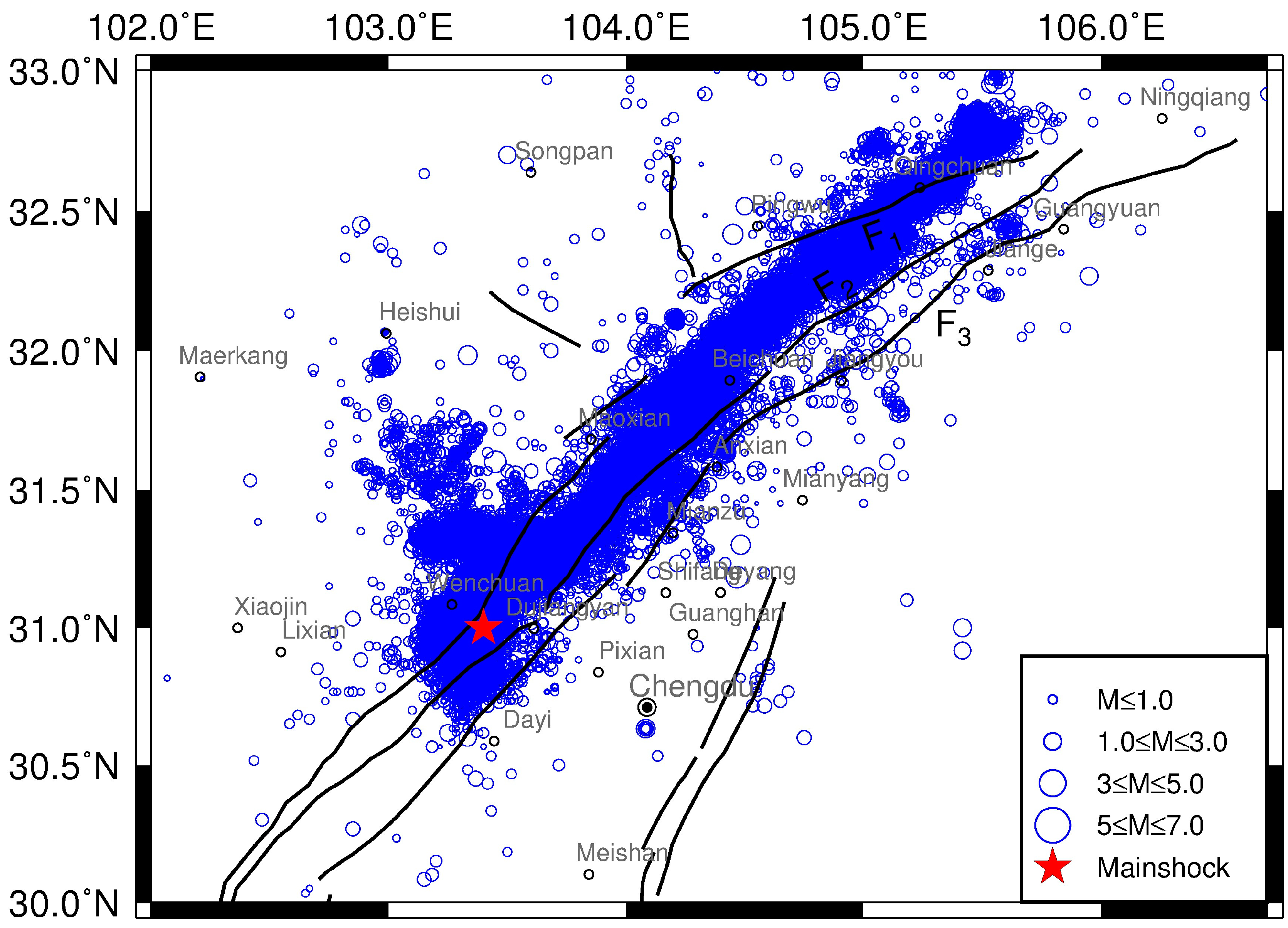
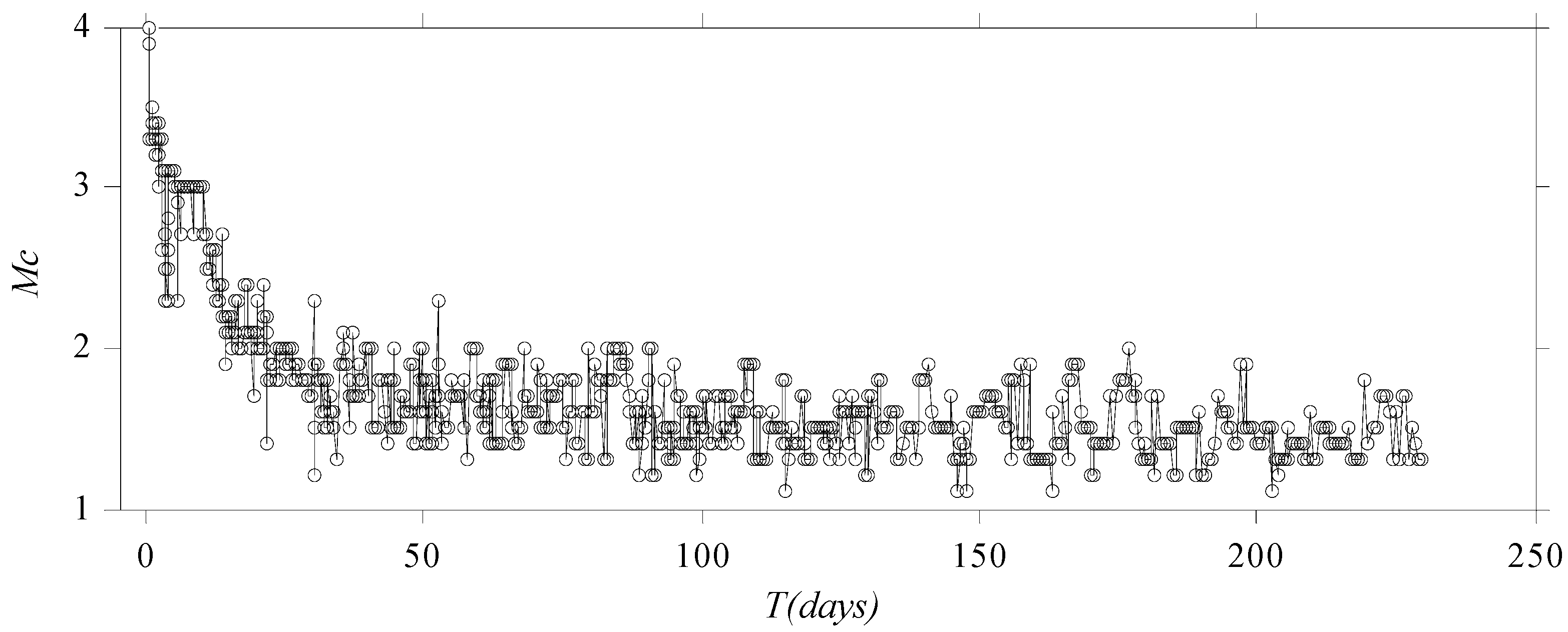

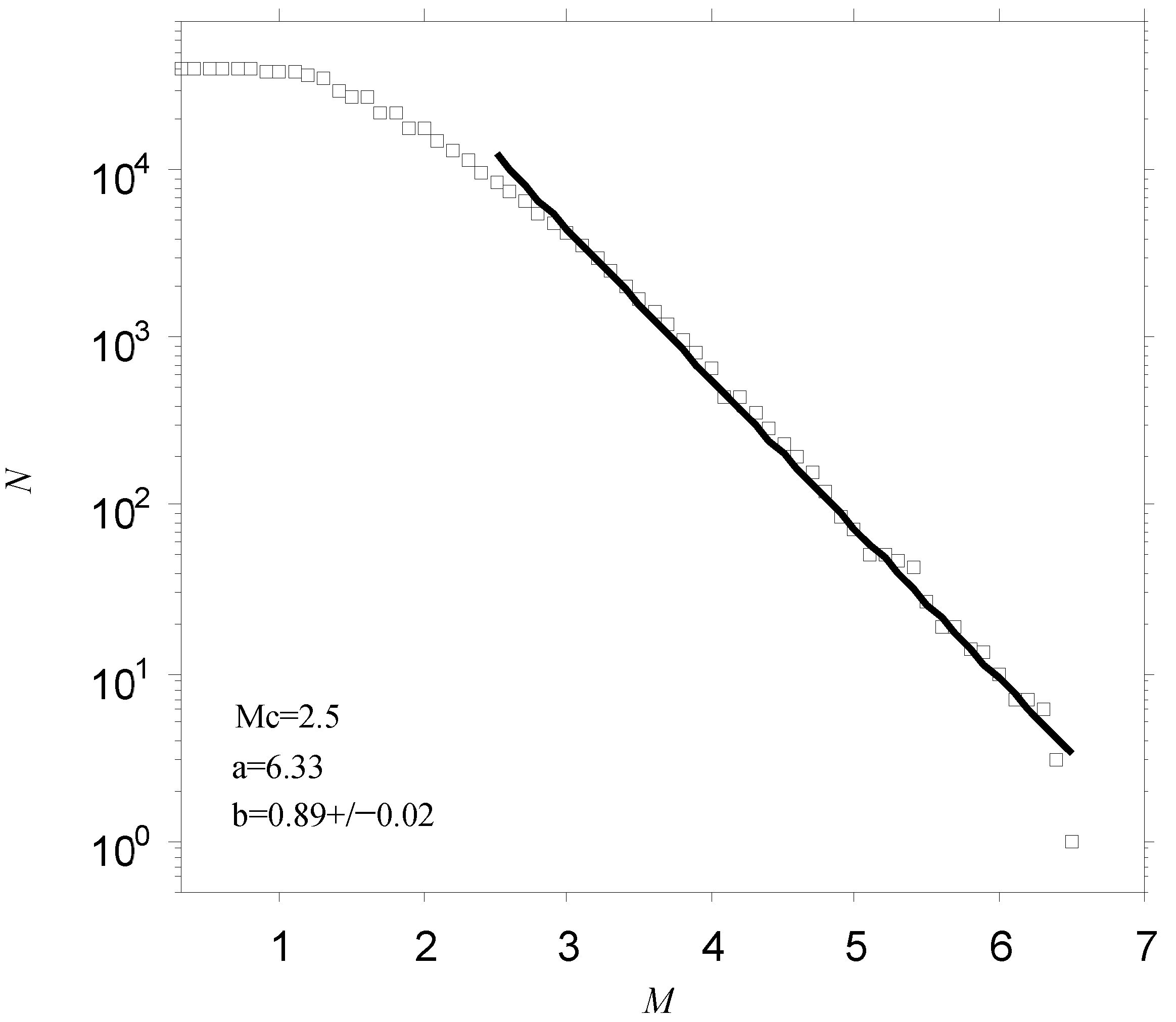
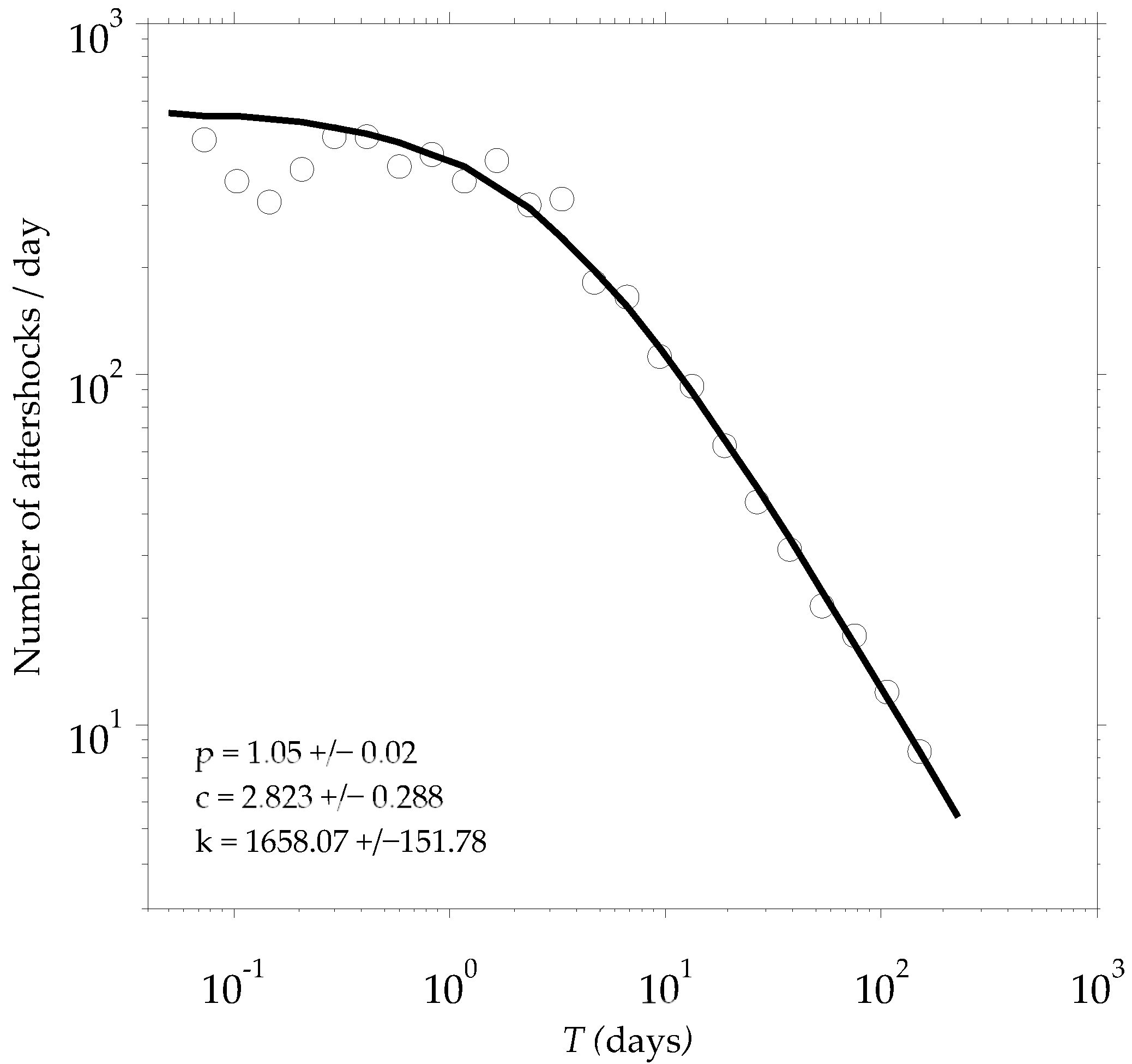
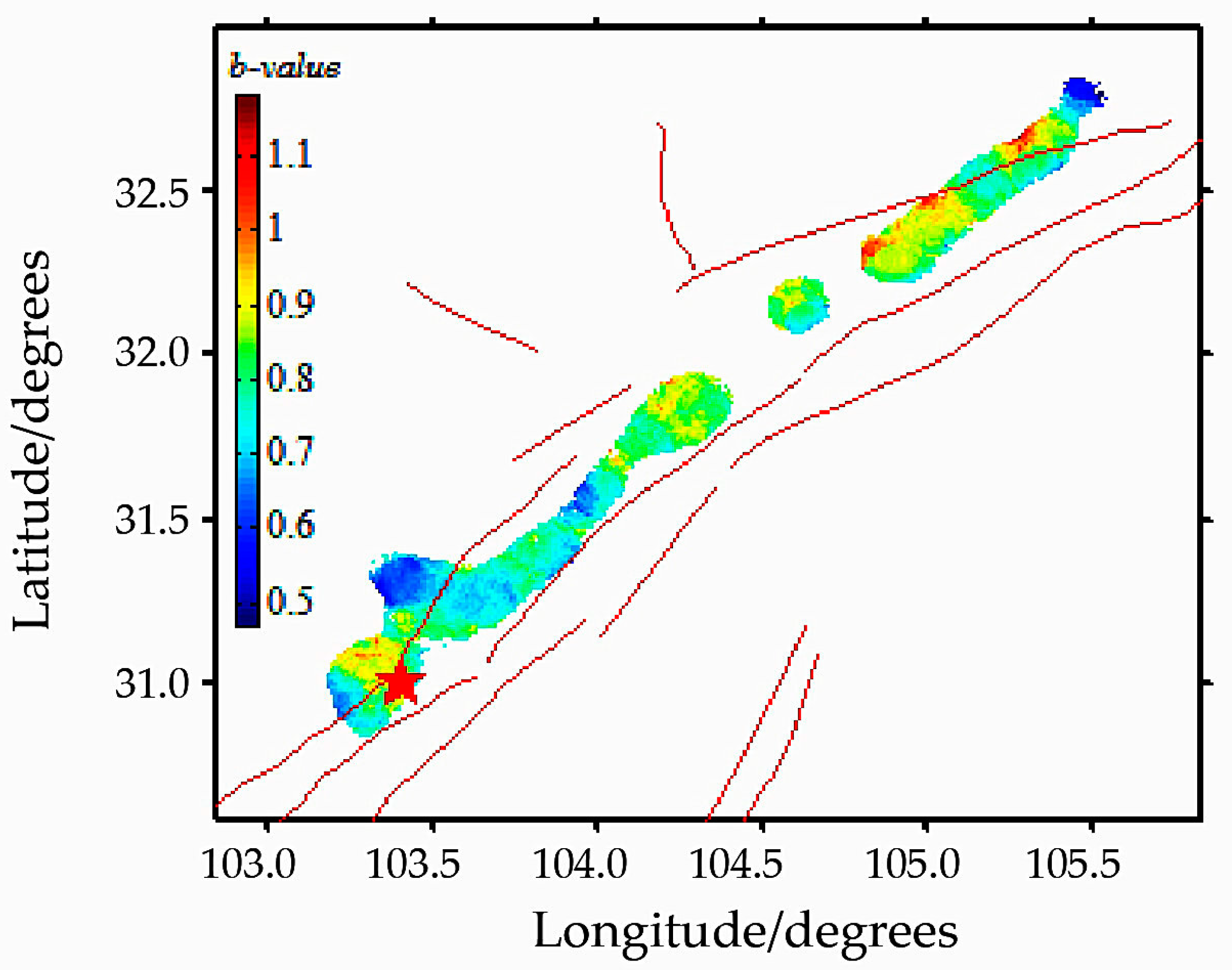
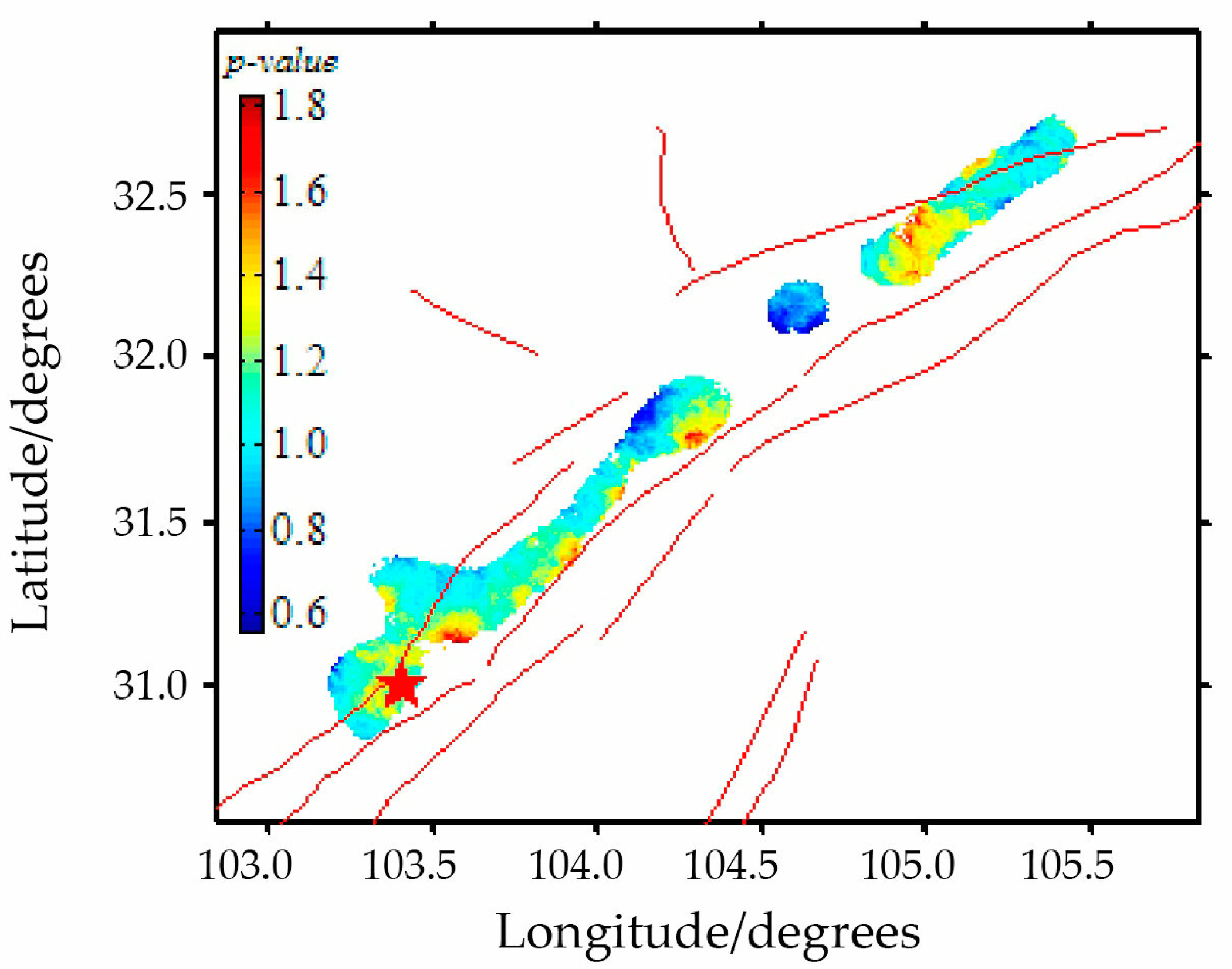
| No. | (Days) | p-Value | c-Value | |
|---|---|---|---|---|
| 1 | 0.05 | 2.4 | 1.00 ± 0.02 | 5.119 ± 0.485 |
| 2 | 0.05 | 2.6 | 1.03 ± 0.02 | 3.364 ± 0.335 |
| 3 | 0.05 | 2.8 | 1.07 ± 0.02 | 2.461 ± 0.259 |
| 4 | 0.05 | 3.0 | 1.12 ± 0.02 | 1.942 ± 0.218 |
| 5 | 0.05 | 3.2 | 1.10 ± 0.02 | 1.181 ± 0.156 |
| 6 | 0.1 | 2.4 | 1.00 ± 0.02 | 5.114 ± 0.491 |
| 7 | 0.1 | 2.6 | 1.03 ± 0.02 | 3.334 ± 0.339 |
| 8 | 0.1 | 2.8 | 1.07 ± 0.02 | 2.426 ± 0.263 |
| 9 | 0.1 | 3.0 | 1.12 ± 0.02 | 1.909 ± 0.222 |
| 10 | 0.1 | 3.2 | 1.10 ± 0.02 | 1.146 ± 0.160 |
Disclaimer/Publisher’s Note: The statements, opinions and data contained in all publications are solely those of the individual author(s) and contributor(s) and not of MDPI and/or the editor(s). MDPI and/or the editor(s) disclaim responsibility for any injury to people or property resulting from any ideas, methods, instructions or products referred to in the content. |
© 2024 by the authors. Licensee MDPI, Basel, Switzerland. This article is an open access article distributed under the terms and conditions of the Creative Commons Attribution (CC BY) license (https://creativecommons.org/licenses/by/4.0/).
Share and Cite
Wu, H.; Xu, W.; Wang, X. An Analysis of the 2008 Ms 8.0 Wenchuan Earthquake’s Aftershock Activity. Appl. Sci. 2024, 14, 4754. https://doi.org/10.3390/app14114754
Wu H, Xu W, Wang X. An Analysis of the 2008 Ms 8.0 Wenchuan Earthquake’s Aftershock Activity. Applied Sciences. 2024; 14(11):4754. https://doi.org/10.3390/app14114754
Chicago/Turabian StyleWu, Haoyu, Weijin Xu, and Xia Wang. 2024. "An Analysis of the 2008 Ms 8.0 Wenchuan Earthquake’s Aftershock Activity" Applied Sciences 14, no. 11: 4754. https://doi.org/10.3390/app14114754





